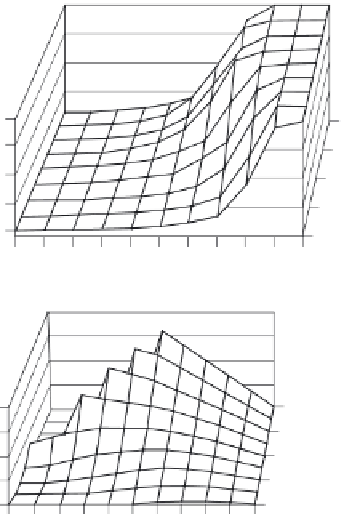Environmental Engineering Reference
In-Depth Information
(a)
200
150
100
50
0
0.9
0.7
0.5
0.3
0.1
20
18
16
14
12
10
8
6
4
2
0
Hunting mortality (%)
(b)
0.9
0.7
0.5
0.3
0.1
20
15
10
5
0
20
16
12
8
4
0
Hunting mortality (%)
Fig. 7.7
Results of population simulations involving Saiga antelopes harvested according to fi xed
quota or fi xed effort. (a) A fi xed quota of animals is harvested each year (expressed as the
proportion of the population that the fi xed number represents). The risk of overexploitation
using a fi xed quota strategy is graphically illustrated by the rapid increase in the probability of
extinction when the number taken is more than around 2% of the population. Note that
harvests containing more males are somewhat less risky (because males are not the ones
producing young). (b) When a fi xed proportion of the population is taken each year (equivalent
to fi xed effort), the maximum yield occurs at values of around 10% or more. Yield is expressed
here in terms of millions of Russian roubles, with highest values for harvests that include more
males with their valuable horns. (After Milner-Gulland, 1994.)
about 20,000 animals). Note that the quota can be somewhat larger (equivalent to
3 or 4% of the population) if the catch is made up predominantly of males. This is
because females are the ones that produce offspring and most males are surplus to
requirements in this respect. Using a fi xed effort approach, on the other hand, about
10% of the population can be safely harvested. Figure 7.7b is like the yield vs effort
curve in Figure 7.3b, but note that the yield is shown in terms of the value of the
harvest (in Russian roubles) rather than individuals harvested. The harvest is much
more valuable when a large proportion of harvested individuals are males, because
of the value of their horns.
7. 2 . 3
Management
by constant
escapement - in time
Another approach, based around the MSY idea, does not prescribe the number of
animals to be included in the harvest but focuses instead on the number that are to
be left behind. The idea, then, is to leave a minimum fi xed number of breeding
individuals at the end of each hunting season, a strategy called
constant escapement
.
This is a particularly safe option because it rules out the accidental removal of all




































Search WWH ::

Custom Search